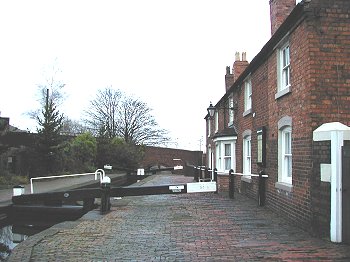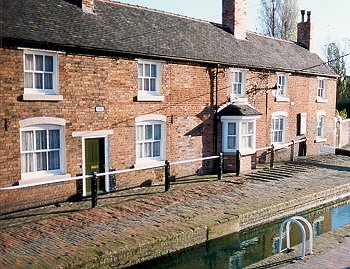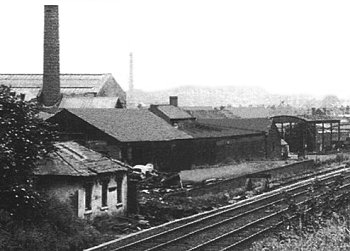Industry, Water and Rail
The
industrial revolution gave to England an enormous variety of
industrial architecture, structures and engineering works, much
of it only being now appreciated. Often a care and attention to
architectural detail was lavished on these buildings that went
beyond their functional need. Mills built in the 17th century
can, at first glance, be taken for country houses, as mill
owners sought respectability for the their profession by
disguising its nature. In a town such as Wolverhampton, where
industry was so diverse, industrial premises reflect this,
ranging from the small workshops to large factories. Not all
industrial premises were purpose built; many of the smaller ones
especially were adapted from other buildings. One form of
building that lent itself to these in more recent times was
redundant Nonconformist chapels. We had thought that there were
no chapels converted to industrial use in Wolverhampton. However
at the bottom of Temple Street is a small premise that, despite
having a new façade, looks by its side windows as if it may once
have been religious building. The large numbers who converted to
Nonconformism, and the chapels built to serve them, were not
sustainable when numbers began to decline. The problem of
redundant chapels is at present acute in parts of Wales.
|
|

The old Chubb lock works. |
Both
Wolverhampton and parts of Willenhall are synonymous with lock
making and one of the most famous names is Chubb. Within
Wolverhampton town centre, there are remarkably few industrial
premises, but one is particularly striking and that is the former
Chubb Lock factory in Railway Street that dates from 1899. It is a
dramatic building of five storeys, occupying a prominent corner
position. It is of unusual shape, being triangular with a stair well
at the apex. It has recently been sensitively adapted for use as a
cinema and arts centre. |
| The 18th
century saw rapid developments in the field of transport. Turnpike
roads, first introduced in the 17th century, spread rapidly and
gained in popularity until they linked at least all the major towns
with reasonably prepared roads. Wolverhampton Turnpike Trust was set
up to develop through Tettenhall to Shifnal. Tettenhall was also the
scene of a major rock cutting when Thomas Telford took through a
section of the London-Holyhead Road. By 1763 no less than seven
turnpike roads met at Wolverhampton. |
|
It was,
though, the coming of the canals that provided industry and
commerce with a means of transporting heavy or bulky goods. The
canal network that developed was of prime importance to the
development of the midlands in general and the Black Country in
particular, for Birmingham and the Black Country were at the
heart of the English canal system. In the area between
Birmingham, Wolverhampton and the Teme valley there is a network
of canals at three levels approached by a long flight of locks. |

Canalside cottages and lock number one.
|
| There are
tunnels, signposts, tollhouses and lock keepers cottages. This
system was considerably extended in the 19th century.
Unfortunately nothing remains of Wolverhampton’s turnpike
system, although tollhouses exist on the Willenhall Road. The
canal though has provided us with some interesting arrangements
of Victorian buildings, though not as many as we would wish.
The
Staffordshire and Worcester Canal that runs through the
outskirts of Wolverhampton and partly financed by the town’s
businessmen, was the work of the great canal engineer James
Brindley. The Act of Parliament authorising the canal was passed
in 1776 and Brindley was able to complete the forty-six mile
route in six years. The canal begins at Great Haywood on the
Trent and Mersey Canal and follows the valleys of the Penk,
Smestow and Stour to join the Severn at Stourbridge. The
Staffordshire and Worcester canal is joined just out of town at
Aldersley by Telford’s Birmingham Canal and it is this which
runs across the bottom of Broad Street. Later the canal was
extended to Nantwich under the name of the Birmingham Liverpool
Junction.
|
|

Another view of the canal cottages.
|
Until the
1970s a graceful cast iron bridge took the Wednesfield Road over
the canal, this has now been removed to the Black Country Living
Museum where it can still be appreciated. Near to the modern
bridge is an arrangement of wharves that after having served as
industrial premises have now been converted to use as a
nightclub, currently defunct. In Broad Street Basin there is an
interesting group of canal cottages. |
| It is often
asserted that the coming of the railways brought about the sudden
demise of canals and whilst it is true that there was some
consternation amongst canal proprietors the change was not so
dramatic as is often thought, especially in the midlands where the
canal network was both complex and efficient and could often not be
improved upon by the railways. The Cannock extension was built as
late as 1853, a decade after “railway mania”. |
|
When the
railways came to Wolverhampton, providing great stimulus to its
industries, it was at the centre of controversy between two
rival companies.
The
Grand Junction Railway, which connected Birmingham with the
Liverpool and Manchester line, was opened in 1837. As lines only
approached the centre of town as closely as was necessary to
make a connection, the Grand Junction came no nearer than Heath
Town, then Wednesfield Heath.
|

Wednesfield Heath Railway Station, long
after closure.
|
|
The
name Station Road is a reminder of where it once was. An
additional problem for Wolverhampton was the fact that it was on
hill.
|

|
|

|
|

|
Return to
The Chapel |
|
Return to the
contents |
|
Proceed to
Schools and Colleges |
|